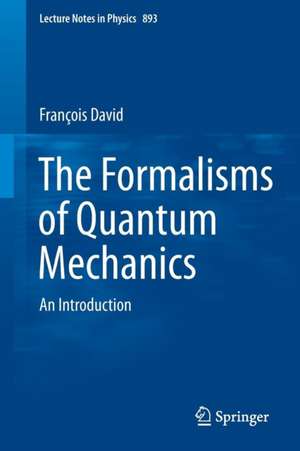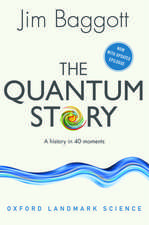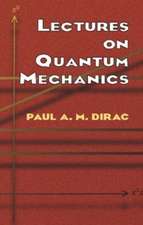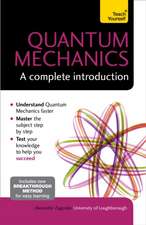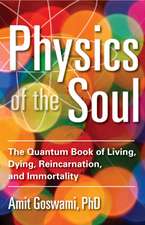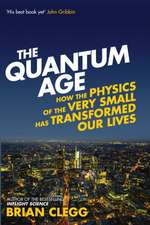The Formalisms of Quantum Mechanics: An Introduction: Lecture Notes in Physics, cartea 893
Autor Francois Daviden Limba Engleză Paperback – 19 noi 2014
The “standard” formulation of quantum mechanics (involving the Hilbert space of pure states, self-adjoint operators as physical observables, and the probabilistic interpretation given by the Born rule) on one hand, and the path integral and functional integral representations of probabilities amplitudes on the other, are the standard tools used in most applications of quantum theory in physics and chemistry. Yet, other mathematical representations of quantum mechanics sometimes allow better comprehension and justification of quantum theory. This text focuses on two of such representations: the algebraic formulation of quantum mechanics and the “quantum logic” approach. Last but not least, some emphasis will also be put on understanding the relation between quantum physics and special relativity through their common roots - causality, locality and reversibility, as well as on the relation between quantum theory, information theory, correlations and measurements, and quantum gravity.
Quantum mechanics is probably the most successful physical theory ever proposed and despite huge experimental and technical progresses in over almost a century, it has never been seriously challenged by experiments. In addition, quantum information science ha
s become an important and very active field in recent decades, further enriching the many facets of quantum physics. Yet, there is a strong revival of the discussions about the principles of quantum mechanics and its seemingly paradoxical aspects: sometimes the theory is portrayed as the unchallenged and dominant paradigm of modern physical sciences and technologies while sometimes it is considered a still mysterious and poorly understood theory, waiting for a revolution. This volume, addressing graduate students and seasoned researchers alike, aims to contribute to the reconciliation of these two facets of quantum mechanics.
Din seria Lecture Notes in Physics
- 19%
 Preț: 423.99 lei
Preț: 423.99 lei - 17%
 Preț: 360.73 lei
Preț: 360.73 lei -
 Preț: 429.22 lei
Preț: 429.22 lei - 17%
 Preț: 427.62 lei
Preț: 427.62 lei - 17%
 Preț: 460.25 lei
Preț: 460.25 lei -
 Preț: 427.96 lei
Preț: 427.96 lei -
 Preț: 481.93 lei
Preț: 481.93 lei - 17%
 Preț: 494.64 lei
Preț: 494.64 lei -
 Preț: 281.90 lei
Preț: 281.90 lei - 17%
 Preț: 493.20 lei
Preț: 493.20 lei - 17%
 Preț: 426.72 lei
Preț: 426.72 lei -
 Preț: 365.15 lei
Preț: 365.15 lei -
 Preț: 374.52 lei
Preț: 374.52 lei -
 Preț: 407.98 lei
Preț: 407.98 lei - 20%
 Preț: 428.12 lei
Preț: 428.12 lei -
 Preț: 263.30 lei
Preț: 263.30 lei - 15%
 Preț: 593.73 lei
Preț: 593.73 lei - 15%
 Preț: 528.13 lei
Preț: 528.13 lei -
 Preț: 493.12 lei
Preț: 493.12 lei - 17%
 Preț: 425.68 lei
Preț: 425.68 lei -
 Preț: 280.65 lei
Preț: 280.65 lei -
 Preț: 163.41 lei
Preț: 163.41 lei - 18%
 Preț: 726.59 lei
Preț: 726.59 lei -
 Preț: 394.84 lei
Preț: 394.84 lei - 15%
 Preț: 709.63 lei
Preț: 709.63 lei - 15%
 Preț: 623.90 lei
Preț: 623.90 lei - 20%
 Preț: 476.91 lei
Preț: 476.91 lei - 15%
 Preț: 428.05 lei
Preț: 428.05 lei -
 Preț: 342.78 lei
Preț: 342.78 lei - 18%
 Preț: 851.93 lei
Preț: 851.93 lei -
 Preț: 346.61 lei
Preț: 346.61 lei -
 Preț: 391.57 lei
Preț: 391.57 lei - 15%
 Preț: 633.16 lei
Preț: 633.16 lei -
 Preț: 451.71 lei
Preț: 451.71 lei - 5%
 Preț: 1497.80 lei
Preț: 1497.80 lei -
 Preț: 374.85 lei
Preț: 374.85 lei -
 Preț: 380.07 lei
Preț: 380.07 lei - 15%
 Preț: 516.14 lei
Preț: 516.14 lei - 15%
 Preț: 583.78 lei
Preț: 583.78 lei - 15%
 Preț: 508.60 lei
Preț: 508.60 lei -
 Preț: 469.71 lei
Preț: 469.71 lei -
 Preț: 388.90 lei
Preț: 388.90 lei - 15%
 Preț: 500.24 lei
Preț: 500.24 lei -
 Preț: 386.52 lei
Preț: 386.52 lei - 15%
 Preț: 472.88 lei
Preț: 472.88 lei -
 Preț: 424.27 lei
Preț: 424.27 lei -
 Preț: 380.07 lei
Preț: 380.07 lei - 15%
 Preț: 500.01 lei
Preț: 500.01 lei
Preț: 314.41 lei
Nou
Puncte Express: 472
Preț estimativ în valută:
60.17€ • 62.46$ • 50.17£
60.17€ • 62.46$ • 50.17£
Carte tipărită la comandă
Livrare economică 22 martie-05 aprilie
Preluare comenzi: 021 569.72.76
Specificații
ISBN-13: 9783319105383
ISBN-10: 3319105388
Pagini: 157
Ilustrații: VII, 157 p. 26 illus., 12 illus. in color.
Dimensiuni: 155 x 235 x 12 mm
Greutate: 0.25 kg
Ediția:2015
Editura: Springer International Publishing
Colecția Springer
Seria Lecture Notes in Physics
Locul publicării:Cham, Switzerland
ISBN-10: 3319105388
Pagini: 157
Ilustrații: VII, 157 p. 26 illus., 12 illus. in color.
Dimensiuni: 155 x 235 x 12 mm
Greutate: 0.25 kg
Ediția:2015
Editura: Springer International Publishing
Colecția Springer
Seria Lecture Notes in Physics
Locul publicării:Cham, Switzerland
Public țintă
GraduateCuprins
Introduction.- The Standard Formulations of Classical and Quantum Mechanics.- The Algebraic Quantum Formalism.- The Quantum Logic Formalism.- Information, Correlations, and more.
Recenzii
“First, let me tell you that this is a great book, both for physicist and philosophers of physics. … The author is an expert in the field and the book is based on several of his lectures to students and researchers. … I recommend this book to you if you are a graduate student or someone interested in the formalisms of quantum mechanics. It is a pleasure reading and a very important text for the future.” (Philosophy, Religion and Science, June, 2016)
“It is a fantastic book for those who are already aware of quantum machanics and wish to revisit or have an updated approach to many topics in these disciplines, mainly topics concerning the distinct formalisms of such issues. … it is quite useful for anyone interested in true quantum mechanics. It has the virtue of gathering material that may not otherwise be found easily in a single volume.” (Décio Krause and Jonas Rafael Becker Arenhart, Mathematical Reviews, July, 2015)
“It is a fantastic book for those who are already aware of quantum machanics and wish to revisit or have an updated approach to many topics in these disciplines, mainly topics concerning the distinct formalisms of such issues. … it is quite useful for anyone interested in true quantum mechanics. It has the virtue of gathering material that may not otherwise be found easily in a single volume.” (Décio Krause and Jonas Rafael Becker Arenhart, Mathematical Reviews, July, 2015)
Textul de pe ultima copertă
These lecture notes present a concise and introductory, yet as far as possible coherent, view of the main formalizations of quantum mechanics and of quantum field theories, their interrelations and their theoretical foundations.
The “standard” formulation of quantum mechanics (involving the Hilbert space of pure states, self-adjoint operators as physical observables, and the probabilistic interpretation given by the Born rule) on one hand, and the path integral and functional integral representations of probabilities amplitudes on the other, are the standard tools used in most applications of quantum theory in physics and chemistry. Yet, other mathematical representations of quantum mechanics sometimes allow better comprehension and justification of quantum theory. This text focuses on two of such representations: the algebraic formulation of quantum mechanics and the “quantum logic” approach. Last but not least, some emphasis will also be put on understanding the relation between quantum physics and special relativity through their common roots - causality, locality and reversibility, as well as on the relation between quantum theory, information theory, correlations and measurements, and quantum gravity.
Quantum mechanics is probably the most successful physical theory ever proposed and despite huge experimental and technical progresses in over almost a century, it has never been seriously challenged by experiments. In addition, quantum information science ha
s become an important and very active field in recent decades, further enriching the many facets of quantum physics. Yet, there is a strong revival of the discussions about the principles of quantum mechanics and its seemingly paradoxical aspects: sometimes the theory is portrayed as the unchallenged and dominant paradigm of modern physical sciences and technologies while sometimes it is considered a still mysterious and poorly understood theory, waiting for a revolution. This volume, addressing graduate students and seasoned researchers alike, aims to contribute to the reconciliation of these two facets of quantum mechanics.
The “standard” formulation of quantum mechanics (involving the Hilbert space of pure states, self-adjoint operators as physical observables, and the probabilistic interpretation given by the Born rule) on one hand, and the path integral and functional integral representations of probabilities amplitudes on the other, are the standard tools used in most applications of quantum theory in physics and chemistry. Yet, other mathematical representations of quantum mechanics sometimes allow better comprehension and justification of quantum theory. This text focuses on two of such representations: the algebraic formulation of quantum mechanics and the “quantum logic” approach. Last but not least, some emphasis will also be put on understanding the relation between quantum physics and special relativity through their common roots - causality, locality and reversibility, as well as on the relation between quantum theory, information theory, correlations and measurements, and quantum gravity.
Quantum mechanics is probably the most successful physical theory ever proposed and despite huge experimental and technical progresses in over almost a century, it has never been seriously challenged by experiments. In addition, quantum information science ha
s become an important and very active field in recent decades, further enriching the many facets of quantum physics. Yet, there is a strong revival of the discussions about the principles of quantum mechanics and its seemingly paradoxical aspects: sometimes the theory is portrayed as the unchallenged and dominant paradigm of modern physical sciences and technologies while sometimes it is considered a still mysterious and poorly understood theory, waiting for a revolution. This volume, addressing graduate students and seasoned researchers alike, aims to contribute to the reconciliation of these two facets of quantum mechanics.
Caracteristici
Based on course-tested material Aims at presenting a coherent view on the subject matter Introductory and tutorial presentation suitable as additional reading for advanced quantum mechanics courses
